Architecture
Last updated: 10-22-2014
Within This Page
Introduction
The modern profession of architecture echoes with its origins, its rich history, and the fast-paced changes of the 21st century. Through antiquity, architecture and construction were united by the cultural intentions of a "Master Builder," who balanced art, science, materials, form, style and craft to achieve his vision."The regulated profession of architecture is relatively new. Yet there have been architects for as long as societies have built, with little distinction between designers and builders. In ancient, traditional cultures and languages, the same word was used for both architect and builder. Construction was an integrated craft in which the master mason or master carpenter knew how to design, to assemble labor and materials, to estimate costs, to manage the construction process, and to erect structures from foundation to roof."
(Roger K. Lewis, p.149, from Architect? A Candid Guide to the Profession)
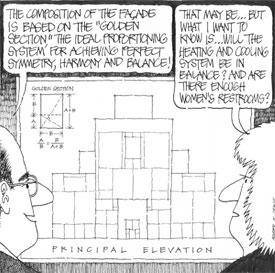 Roger K. Lewis illustrates that architects balance ideas, form, and function.
Roger K. Lewis illustrates that architects balance ideas, form, and function.(Courtesy Roger K. Lewis)
This specialist role now forms the basis of most widely accepted modern definitions of architectural practice. For instance, the United States Department of Labor defines architects as licensed professionals who transform space needs into concepts, images, and plans of buildings to be constructed by others. Still, echoes of the "Master Builder" remain, as architects are usually responsible for orchestrating and coordinating the work of many disciplines during the design phases. It is not unusual for architects also to be involved in the early stages of project feasibility, to help clients define a program, choose the site, and otherwise decide on highest and best uses.
Description
Legal and Cultural Definitions
The discipline of architecture has both legal and cultural definitions. In the United States, all states have regulations that govern conditions of licensure, registration, use of the title "architect" and the provision of professional services, succinctly summarized by The American Institute of Architects. Each state or jurisdiction creates its own requirements for each of these aspects of the discipline. While legal definitions mandate the ways in which the profession is responsible for safeguarding the health, safety, and welfare of the public, cultural definitions characterize the ways in the discipline responds to social, aesthetic, and ethical aspects of making cities, buildings, and landscapes. A "whole building" approach must necessarily incorporate both sets of disciplinary definitions.Architect's Role
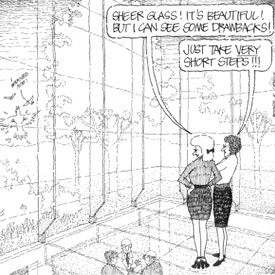 Sometimes beauty and functionality are in tension, as seen by Roger K. Lewis. (Courtesy Roger K. Lewis)
Sometimes beauty and functionality are in tension, as seen by Roger K. Lewis. (Courtesy Roger K. Lewis)According to some industry analysts, such as Carl Sapers, the architect's role has been further limited by the idea that buildings are commodities, consisting of assemblies of standard materials and systems best understood by their suppliers and constructors. New forms of project delivery, including "design/build", "bridging", and "construction management", come out of a belief that architects are no longer able to stay abreast of complex information in order to lead the design process on the owner's behalf. (Carl Sapers, "Toward Architectural Practice in the 21st Century," in Harvard Design Magazine, Fall 2003/Winter 2004)
However, this standardized approach to efficient building design is not necessarily synonymous with the requirements for whole building design. Integrated, high-performance design requires both efficiency and innovation. It requires a design process in which the users, owners, and project participants are all integral team members.
The Composite Master Builder
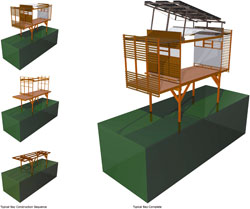 An
innovative approach to efficiency: a prefabricated structure for an
ecologically-sensitive site. Kingman Island Environmental Education
Center competition finalist
An
innovative approach to efficiency: a prefabricated structure for an
ecologically-sensitive site. Kingman Island Environmental Education
Center competition finalist(Courtesy University of Maryland School of Architecture, Planning, and Preservation.)
The cast of specialists is potentially quite large, and depending on the complexity of the project, can include:
- site professionals, such as planners, civil and environmental engineers, and landscape architects;
- design team members such as programmers, architects, and interior designers;
- building systems experts, such as structural, mechanical, fire protection, and building science and performance engineers;
- construction professionals, including cost estimators, project managers, tradespeople, and craftspeople;
- owners, including financial managers, building users, and operations and maintenance staff; and
- local code and fire officials.
 A
cast of specialists worked together to design building systems using
the building section as a tool. Kingman Island Environmental Education
Center competition finalist
A
cast of specialists worked together to design building systems using
the building section as a tool. Kingman Island Environmental Education
Center competition finalist(Courtesy University of Maryland School of Architecture, Planning, and Preservation)
The Team Needs a Leader
The legal obligations of the profession, comprehensive training in holistic problem-solving, and an understanding of broad cultural concerns make architects ideally suited for the leadership of design teams.Architects in the United States have historically been bound by comprehensive legal requirements and responsibilities for the building design. They are legally obligated to safeguard the public health, safety, and welfare. This presumes that architects maintain at minimum a clear overview of the project team's work. Arguably, the most effective way to discharge this public duty is to oversee and coordinate the work of the project team.
The profession emphasizes comprehensive training in the arts and sciences, as well as a holistic approach to design problems. Architectural education teaches both abstract and concrete problem-solving. Its core skills are learned and re-learned, in an iterative process that incorporates history, theory, technology, and other social and cultural factors. Architects are both specialists and generalists, which ideally enables them to communicate effectively with other specialists while maintaining the "big-picture" view of the project goals.
In addition to health, safety, and welfare considerations, buildings incorporate the culture that created them. The built environment is both "mirror and lamp", shaping while acting as a repository of cultural meaning. As Churchill said, "We shape our buildings; thereafter they shape us." With their knowledge of the arts and culture, architects hold a comprehensive understanding of the project context and can help the design team move beyond mere problem-solving.
Education, Training, and Process for Whole Building Design
 Holistic
building design comes out of a comprehensive understanding of the
project context. Kingman Island Environmental Education Center
competition finalist.
Holistic
building design comes out of a comprehensive understanding of the
project context. Kingman Island Environmental Education Center
competition finalist.(Courtesy University of Maryland School of Architecture, Planning, and Preservation)
Continuing education is a lifelong endeavor for practicing architects and is mandated in many jurisdictions, as well as by The American Institute of Architects (AIA). Typically, this education involves technical training, management courses, legal and liability issues, and learning about new materials and products. The practice of seeking out training in the various aspects of leadership of an integrated design team, such as workshop facilitation, is not yet common. However, critical skills are needed to assume this role, which was addressed in a recent article in Environmental Building News. Current practitioners of integrated design, such as Terry Brennan of Camroden Associates, observe that architects have the intention to become cooperative but lack the skills. "The lead designer must be skilled in nurturing and giving form to the collective vision, rather than expressing his or her own vision. Not all architects are comfortable with this role, which is more akin to that of a midwife than to that of an individual artist." (EBN, November 2004, "Integrated Design" feature article)
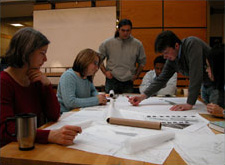 Project
charrettes for the Kingman Island Environmental Education Center
establish early and regular interaction among design team members.
Project
charrettes for the Kingman Island Environmental Education Center
establish early and regular interaction among design team members.(Courtesy University of Maryland School of Architecture, Planning, and Preservation)
The whole team interaction focuses on collaborative, integrated problem solving, to address issues such as:
- accessibility
- aesthetics
- cost-effective solutions
- functional and operational considerations
- preservation of cultural artifacts
- productive environment for users
- safety and security
- environmental sustainability.
Emerging Issues
Evolution of Building Types
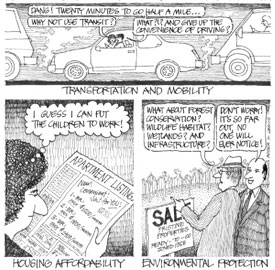 Roger K. Lewis' view of emerging issues
Roger K. Lewis' view of emerging issues(Courtesy Roger K. Lewis)
Smart Growth, Cities, and Landscapes
Evolutions in current architectural practice also include a re-commitment to community and public service, and an abiding interest and concern for our cities and landscapes. Both find articulation in "smart growth" initiatives, inventive real estate investment and development schemes, urban redevelopment, and trends in the historic preservation of cities and buildings. Additionally, cultural preservation is seen as equally important to building fabric preservation and conservation. Sustainable design takes these concerns further in advocating a beneficial relationship between the built and natural environments.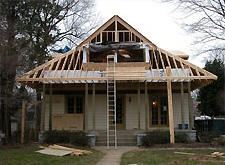
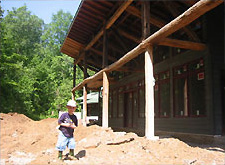 Left: Cultural preservation and resource conservation in action at the Bradley residence, designed by Amy E. Gardner AIA.
Left: Cultural preservation and resource conservation in action at the Bradley residence, designed by Amy E. Gardner AIA.(Photo by the authors)
And Right: In the Brown residence designed by Julie Gabrielli, sustainable design takes a "cradle-to-cradle" view, combining antique timbers with 21st century technologies—a "wondrous hybrid".
(Photo by the authors)
Impact of Technology
Globalization of practice, especially as it relates to changes in the workforce, labor, and practice, has the potential to dramatically change the discipline. The outsourcing of design and drawing labor overseas; the robotic manufacturing of building components and materials; and the use of sophisticated three-dimensional computer programs to design buildings raise questions and challenge current modes of project delivery. Trends in computer-aided building design and manufacturing figure prominently in any discussion of project delivery methods.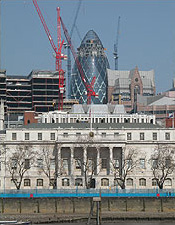 Norman
Foster's Swiss Re Headquarters in London demonstrates sophisticated
building technologies developed through advanced modeling systems.
Norman
Foster's Swiss Re Headquarters in London demonstrates sophisticated
building technologies developed through advanced modeling systems.(Photo by the authors)
Industry experts predict that BIM will revolutionize not only the delivery of design and documents, but also the relationship between design team members, owners, and construction entities and the relationship between design and construction activities. However, Ken Sanders, FAIA, observes in the September 2004 issue of Architectural Record: that "the critical path isn't BIM, but rather process innovation squarely focused on people, partnerships, shared expertise, and timely decision making." Nevertheless changes in the way that design teams conceive, develop, and communicate information about buildings are positioned to have a dramatic impact on the practice of architecture.
Project Delivery Methods
Architectural projects can be executed through a variety of project delivery methods. Prior to the twentieth century, there was a single project delivery method—the architect won a commission, produced drawings for design and construction, pulled labor and materials lists together, and oversaw the building of the project. As architects moved the discipline towards a profession and away from a craft, different project delivery methods developed to accommodate the changing relationship between architects and craftspeople.Currently, three project delivery methods dominate in the United States: design-bid-build, design-build, and construction management. In order to assist owners and the construction industry by establishing accepted definitions of project delivery methods, the AIA and the Associated General Contractors of America jointly created a document entitled "Primer on Project Delivery", offering information on these methods for owners and architects. However, each method may be summarized to capture a flavor of the intent. Design-bid-build is a method by which project delivery is separated into three distinct phases: a project is designed and documented with drawings and specifications, competitively bid to multiple general contractors, and then built by the general contractor, guided by a contract with the owner of the project. Design-build is a project delivery method in which a single entity (for example a general contractor in a joint venture with a design team including architects and engineers) holds a single contract with an owner for both the design and construction of a project. Finally, the construction management method is a process that involves the coordination and management of the entire process via a single entity—from site survey through occupation. It encompasses the evaluation, selection, and management of all contractors, as well as the administration of the project budget relative to the implementation of design.
Project Management within the Architect's Office
Project management is also a significant term within architectural practice. In the execution of a project, the work of all disciplines and relationships needs to be orchestrated—architectural design, the coordination of other design disciplines, team members' design and drawing work, client relationships, time and fee tracking, to name a few. This orchestration is achieved through the architectural project manger, a conductor of sorts. The goals of project management include the orchestration and integration of an overlapping set of issues including project scope, schedule and budgets, development of the design, management of the delivery team throughout the various phases of the project from inception to initial occupancy.Contracts
Both project delivery methods and internal project management roles are evolving in a manner commensurate with evolutions in digital technologies, building technology, and construction case law. Similarly, contracts evolve following events in construction and professional case law. Currently, more than 90 documents authored by The American Institute of Architects constitute an industry standard for contracts and project administration forms—according to the AIA, "a significant body of case law concerning contracts for design and construction is based largely on the language of AIA standard forms."Conclusion
The changing context of architectural practice points to challenges to and opportunities for whole building design. Evolutions such as BIM have the potential to facilitate—or further complicate—integrated work. Areas of evolution should be carefully analyzed for potential avenues for integrated rather than episodic action, allowing the objectives of whole building design to be met in a holistic fashion.Relevant Codes and Standards
History of Building Codes
 Roger K. Lewis captures the complexity and magnitude of code requirements.
Roger K. Lewis captures the complexity and magnitude of code requirements.(Courtesy Roger K. Lewis)
Until recently, most building codes have been prescriptive, effectively casting design professionals in the role of negotiators between the owner's ideas and the realities of codes. High-performance, integrated building design recently started leading design teams away from this "just barely legal" approach. As a tool to aid in this process, the new performance-based building codes give the design team more flexibility in meeting requirements.
1. List of Codes
The international Code Council (ICC) was formed from the joining of publishers of National and Standard Building Codes, Building Officials and Code Administrators International, the Southern Building Code Congress International, and the International Conference of Building Officials. The result of their merging was the International Code Series—part of the U.S.'s first unified comprehensive and coordinated building codes.A. U.S. Code Organizations:
- International Code Council (ICC)
- International Conference of Building Officials (ICBO), member of ICC
- Southern Building Code Congress International, Inc. (SBCCI), member of ICC
- International Association of Plumbing and Mechanical Officials (IAPMO)
- National Fire Protection Association (NFPA)
- Underwriters Laboratories (UL)
- Americans with Disabilities Act Guidelines (ADAAG)
- International Code Series:
- International Building Code (IBC)
- International Energy Conservation Code (IECC)
- International Fire Code (IFC)
- International Fuel Gas Code (IFGC)
- International Mechanical Code (IMC)
- International Plumbing Code (IPC)
- International Property Maintenance Code (IPMC)
- International Residential Code (IRC)
- National Building Code (BOCA NBC)
- National Fire Protection Association codes (NFPA)
- National Electric Codes (NEC)
- Uniform Building Code (UBC)
2. List of Standards and Organizations
Many of these organizations have voluntary standards for quality assurance. Others publish standards that are referenced by the LEED Green Building Rating Guide, for meeting requirements of various credits.- American Forest and Paper Association (AFPA) (formerly the National Forest Products Association)
- American Institute of Steel Construction (AISC)
- American National Standards Institute (ANSI)
- APA—The Engineered Wood Association (APA)
- American Society of Heating, Refrigerating and Air-Conditioning Engineers (ASHRAE)
- ASTM International
- Architectural Woodwork Institute (AWI)
- American Wood Council (AWC)
- Federal Emergency Management Agency (FEMA)
- Federal Energy Management Program (FEMP)
- Federal Housing Administration (FHA)
- Forest Stewardship Council (FSC)
- Illuminating Engineering Society of North America (IESNA)
- International Performance Measurement and Verification Protocol (IPMVP)
- National Fire Protection Association (NFPA)
- National Association of Home Builders (NAHB)
- National Institute of Standards and Technology (NIST)
- National Institute of Building Sciences - Construction Criteria Base (CCB)
- Underwriters Laboratories (UL)
- U.S. Department of Agriculture, Forest Service, Forest Products Laboratory (FPL)
- U.S. Department of Commerce, National Technical Information Service (NTIS)
- U.S. Department of Energy (DOE)
- U.S. Environmental Protection Agency (EPA)
- U.S. Department of Housing and Urban Development (HUD)
3. Federal and Non Government Databases for Standards and Regulations
- Whole Building Design Guide—Mandates/References
- Whole Building Design Guide—Construction Criteria Base
Major Resources
Professional Associations
- Association of Collegiate Schools of Architecture (ASCA)
- The American Institute of Architects (AIA)
- American Institute of Architecture Students (AIAS)
- National Council of Architectural Registration Boards (NCARB)
- National Architectural Accrediting Board, Inc. (NAAB)
Related Organizations
- Architecture Research Institute, Inc.
- Association for Computer Aided Design in Architecture (ACADIA)
- Building Owners and Managers Association (BOMA)
- Congress for the New Urbanism (CNU)
- Department of Energy (DOE)
- National Association of Homebuilders (NAHB)
- National Association of the Remodeling Industry (NARI)
- National Organization of Minority Architects (NOMA)
- Sustainable Buildings Industry Council (SBIC)
- Urban Land Institute (ULI)
- U.S. Green Building Council (USGBC)
- Links to Other Organizations through NCARB
Bibliography
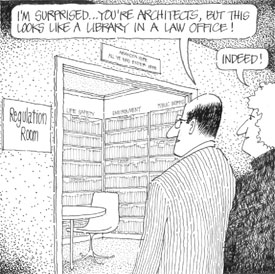 Resources are central to a knowledge-based practice of architecture.
Resources are central to a knowledge-based practice of architecture.(Courtesy Roger K. Lewis)
History/Theory
- A History of Architecture: Settings and Rituals, 2nd edition by Spiro Kostof and Greg Castillo. New York, NY: Oxford University Press, 1995.
- A History of Architectural Theory: From Vitruvius to the Present by Hanno-Walter Kruft. New York, NY: Princeton Architectural Press, 1994.
- Modern Architectural Theory: A Historical Survey, 1673-1968 by Harry Mallgrave. New York, NY: Cambrige University Press, 2005.
- Sir Banister Fletcher's History of Architecture by Sir Banister Fletcher. New York, NY: C. Scribner's Sons, London, UK: B.T. Batsford, 1945.
Building Science, Technology, Materials, and Assembly
- Architectural Graphic Standards, 11th Edition
by Charles Ramsey and Harold Sleeper. New York, NY: John Wiley & Sons, Inc., 2007.
- The Architect's Studio Companion, 3rd Edition by Edward Allen and Joseph Iano. New York, NY: John Wiley & Sons, Inc., 2001.
- Building Envelope by Randall Stout and Michael Garrison. Washington, DC: NCARB, 2004.
- Building Systems Integration Handbook, Reprint Edition by Richard Rush. Newton, MA: Butterworth-Heinemann, 1991.
- Building in Wood: Construction and Detail by Götz Gutdeutsch, et al. Basel, Boston: Birkhauser, Ed. Detail, 1996.
- Building Skins: Concepts, Layers, Material by Christian Schittich. Basel, Boston: Birkhauser, 2002.
- Concrete Construction Manual by Friedbert Kind-Barkauskas, et al. Basel, Boston: Birkhauser, Ed. Detail, 1993.
- EEBA Builders' Guides by Joe Lstiburek and Betsy Pettit. Canada: EEBA, 2001.
- Façade Construction Manual by Thomas Herzog, et al. Basel, Boston: Birkhauser, Ed. Detail, 2004.
- Glass Buildings: Material, Structure and Detail by Heinz Krewinkel. Basel, Boston: Birkhauser, 1998.
- Glass Construction Manual by Christian Schittich. Basel, Boston: Birkhauser, Ed. Detail, 1999.
- Glass in Building by David Button and Brian Pye. Boston, MA: Butterworth Architectural Press, 1993.
- Moisture Control Handbook by Joe Lstiburek and John Carmody. New York, NY: Van Nostrand Reinhold, 1993.
- Laminated Timber Construction by Christian Muller. Basel, Boston: Birkhauser, 2000.
- Roof Construction Manual by Eberhard Schunk, et al. Basel, Boston: Birkhauser, Ed. Detail, 2003.
- Masonry Construction Manual by Günter Pfeifer, et al. Basel, Boston: Birkhauser, Ed. Detail, 2001.
- Steel Construction Manual by Helmut Schulitz, et al. Basel, Boston: Birkhauser, Ed. Detail, 2000.
- Timber Construction Manual by Thomas Herzog, et al. Basel, Boston: Birkhauser, Ed. Detail, 2004.
- Wood Reference Handbook: A Guide to the Architectural Use of Wood in Building Construction Ottawa, Ontario: Canadian Wood Council, 1993.
Sustainable Building Environments
- American Building: The Environmental Forces that Shape It by James M. Fitch, with William Bobenhausen. New York, NY: University Press, 1999.
- Architectural Expression of Environmental Control Systems by George Baird. New York, NY: E&FN Spon Press, 2001.
- Architecture and the Environment: Bioclimatic Building Design by David Lloyd Jones. Woodstock, New York: Overlook Press, 1998.
- The Architecture of the Well-tempered Environment by Reyner Banham. Chicago, IL: University of Chicago Press, 1984.
- Climate and Architecture by Jeffrey Ellis Aronin, New York, NY: AMS Press, 1979.
- Climatic Building Design by Donald Watson and Kenneth Labs, New York, NY: McGraw-Hill, 1993.
- Cradle to Cradle by William McDonough and Michael Braungart. New York, NY: North Point Press, 2002.
- Daylighting Performance and Design, 2nd Edition
by Gregg D. Ander. Hoboken, NJ: John Wiley & Sons, Inc., 2003.
- Daylighting for Sustainable Design by Mary Guzowski. New York, NY: McGraw-Hill, 2000.
- Detailing Light by Jean Gorman. New York, NY: Whitney Library of Design/Watson-Guptill, 1995.
- Design with Climate by Victor Olgyay. Princeton, NJ: Princeton University Press, 1963.
- Design with Nature
by Ian McHarg. New York, NY: John Wiley & Sons, Inc., 1995.
- Ecological Design by Sim Van der Ryn and Stuart Cowan. Washington, DC: Island Press, 1996.
- Eco-Tech by Catherine Slessor, London: Thames and Hudson, 2001.
- Environmental Tradition: Studies in the Architecture of Environment by Dean Hawkes. London, UK: E&FN Spon Press; New York: Chapman & Hall, 1996.
- A Golden Thread: 2500 Years of Solar Architecture and Technology by Ken Butti and John Perlin. New York, NY: Van Nostrand Reinhold, 1980.
- Green Development: Integrating Ecology and Real Estate
by Rocky Mountain Institute, Alex Wilson, Jenifer L. Uncapher, Lisa McManigal, L. Hunter Lovins, Maureen Cureton, William D. Browning. New York, NY: J. Wiley & Sons, Inc., 1998.
- Man, Climate and Architecture, 2nd Edition by Baruch Givoni. New York, NY: Van Nostrand Reinhold, 1981.
- Reshaping the Built Environment by Charles Kibert. Washington, DC: Island Press, 1999.
- Sun, Wind & Light: Architectural Design Strategies, 2nd Edition
by G.Z. Brown and Mark DeKay. New York, NY: John Wiley & Sons, Inc. 2001.
- Sustainable Architecture: Principles, Paradigms and Case Studies by James Steele, New York, NY: McGraw-Hill, 1997.
- Sustainable Architecture and Urbanism by Dominique Gauzin-Muller. Basel, Boston: Birkhauser 2002.
- The Technology of Ecological Building by Klaus Daniels. Basel, Boston: Birkhauser, 1997.
- Thermal Delight in Architecture by Lisa Heschong. Cambridge, MA: MIT Press, 1979.
Practice
- Architect? A Candid Guide to the Profession by Roger K. Lewis. Cambridge, MA: MIT Press, 1998.
- Architect's Essentials of Contract Negotiation by Ava Abramowitz. New York, NY: John Wiley & Sons, Inc., 2002.
- Architect's Handbook of Professional Practice by Joseph Demkin. New York, NY: John Wiley & Sons, Inc., 2004.
- Architectural Practice: A Critical View by Robert Gutman. Princeton, NJ: Princeton Architectural Press, 1988.
- Architecture: Chapters in the History of the Profession, Reprint Edition by Dana Cuff and Spiro Kostof. Berkeley, CA: University of California Press, 2000.
- Architecture: The Story of Practice by Dana Cuff. Cambridge, MA: MIT Press, 1992.
- In the Scheme of Things: Alternative Thinking on the Practice of Architecture by Thomas Fisher. Minneapolis, MN: University of Minnesota Press, 2000.
- A Theory for Practice: Architecture in Three Discourses by Bill Hubbard. Cambridge, MA: MIT Press, 1995.
Digital Technologies
- Advanced Building Simulation Malkawi, Ali, and Augenbroe, Godfried, Eds. New York, NY: Taylor & Francis, 2004.
- Architecture in the Digital Age: Design and Manufacturing Kolarevic, Branko Ed. New York, NY: Taylor & Francis, 2003.
- Performative Architecture: Beyond Instrumentality Kolarevic, Branko and Malkawi, Ali, Eds. New York, NY: Taylor & Francis, 2004.
- Digital Tectonics
Leach, Turnbull, Williams, Eds. London, UK: Wiley-Academy Press, 2004.
Webliography
Building Science, Technology, Materials, and Assembly
a. General:
- Building Science Corporation
- DOE: Building Energy Codes
- ebuild
- HUD User: Housing Production and Technology
- Toolbase Services
- Whole Building Design Guide—Mandates/References
- Whole Building Design Guide—Construction Criteria Base
b. Materials:
- American Concrete Institute (ACI)
- American Institute of Steel Construction (AISC)
- Architectural Woodwork Institute (AWI)
- APA—Engineered Wood Association (APA)
- Canadian Wood Council
- Forest Stewardship Council (FSC)
- Hardwood Information Council
- Natural Building Resources
- Structural Board Association (SBA)
Sustainable Building Environments
a. General:
- BuildingGreen.com
- Built Green
- Center for the Built Environment
- Center for Resourceful Building Technology
- Development Center for Appropriate Technology
- DOE: Building Energy Codes
- Eco-Home™ Network
- Green Building Alliance
- Green Matrix Technology
- Greenroofs.com
- High-Performance Buildings Research
- Institute for the Built Environment
- NAHB Research Center: Guide to Developing Green Builder Programs
- OIKOS: Green Building Source
- Sustainable Buildings Industry Council
- Sustainable Sources
b. Sustainable Design Guidelines:
c. Energy Efficiency and Renewable Energy:
- Alternative Energy Store
- American Council for an Energy Efficient Economy
- Energy and Environmental Building Association (EEBA)
- EnergyStar
- GreenGoat
- HomePerformance.com
- RReDC Energy Tidbits
- The Source for Renewable Energy
d. Recycling:
Journals
- AIArchitect
- Architect
- Architecture Week
- Architectural Digest
- Architectural Record
- Architectural Review
- Archis
- Building Design and Construction
- Detail
- Dwell
- Ecotecture.com
- Environmental Building News
- Environmental Design and Construction
- Fine Homebuilding
- Harvard Design Magazine
- Metropolis
- Residential Architect
- Traditional Building
- Wood Design and Building
Dictionaries and Encyclopedias
- Almanac of Architecture & Design Library 2005 by James P. Cramer, and Jennifer Y. Evans, eds. Atlanta, GA: Greenway Communications, 2004.
- Sturgis' Illustrated Dictionary of Architecture and Building: An Unabridged Reprint of the 1901-1902 Edition by Russell Sturgis. New York, NY: Dover, 1989.
- Dictionary of Architecture & Construction, 3rd Edition by Cyril Harris, Ed. New York, NY: McGraw-Hill, 2000.
- Encyclopedia of Architecture: Design, Engineering & Construction by Joseph Wilkes and Robert Packard. New York, NY: John Wiley & Sons, Inc., 1989.
- Illustrated Encyclopedia of Architects and Architecture by Dennis Sharp. New York, NY: Whitney Library of Design, 1991.
- Multilingual Dictionary of Architecture and Building Terms by Chris Grech. New York, NY: Brunner-Routledge, 1998.
Design and Analysis Tools
- Energy-10
- GSA Sustainable Facilities Tool (SFTool)—SFTool's immersive virtual environment addresses all your sustainability planning, designing and procurement needs.
- IES "Virtual Environment" (IES (USA) Limited)
- REScheck (U.S. DOE Building Energy Codes Program, Residential Compliance)
- TRNSYS - (TRaNsient SYstem Simulation Program)
- VisualDOE (Architectural Energy Corporation)
Training
Education and Continuing Education
See: Professional Organizations aboveAcknowledgements
–Credit and gratitude to Roger K. Lewis FAIA for wisdom, insight, and the use of his cartoons
–Credit and gratitude also to George Holback AIA for the ideas in the section on the the History of Building Codes
No comments:
Post a Comment